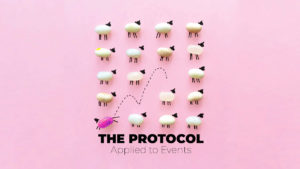Step by step, tips to organize a successful event.
As we have seen in previous posts, there are various types of events, companies usually organize an event to manage and highlight events such as: the launch of a product with their customers, a corporate breakfast with the presence of a journalist, a year-end party with their collaborators, the promotion of the opening of a new brand, etc…
In today’s post we want to tell you about the planning and recommendations for the organization of an event and how you must promote your event in order to make the most out of it and make it a complete success.
When it comes to organizing an event think differently, be creative. You must make a difference, because remember that most of your audience will have attended dozens of events and you must highlight your event, make it unforgettable.
Important, if you do not have the experience or know-how to organize your own event, hire a professional or a company that develops all the points that come with the organization and planning of an event.
We can help you.
To organize a successful event, follow these three stages:
1| PRE-PRODUCTION OR PRE-EVENT
At this stage it is about planning and preparation.
In this first stage we work several aspects, such as, the briefing of the event, the objective of the event, the date, time and local of the event, the list of providers with whom we are going to work, we define the budget of the event and the list of attendees.
Event briefing
This is a common measure to all events.
Before starting any planning, it is important to develop the briefing of the event.
Here you must define the objectives, budget, target audience, number of attendees, the venue of the event, the date and time of the event, the program of the event and the characteristics of the type of event to be held (if a conference, a fair, a congress, an exhibition, etc.)
A good briefing is the instrument for a good management and will give the idea of what the client wants.
Set clear goals and methods to measure success and return on investment.
Maybe you are interested in knowing how a good briefing is developed?
In this link you can learn more about it: https://materiaefimera.com/consejos/brief-o-briefing-de-stands/2020/
Objectives of the event
It is very important to know what objectives are expected to be achieved once the event has been held, what is its philosophy and the message that you want to convey to the attendees.
You need to have clear and very well defined objectives.
So make sure that the production of the event is consistent with the ultimate goal, it is important to have a meeting with all involved parties so that you can convey your expectations to us.
Venue and date of the event
It is an important point when considering how to organize an event.
When choosing a venue, a number of aspects should be taken into account, such as space operating standards, access for attendees and vehicles, availability of production materials, dimensions, storage capacity, etc.
As for the date, the most favorable weekdays are Wednesdays and Thursdays. Important that it does not coincide with any special day: a bank holiday, or a football match, a final of a competition, etc…
Budget
Another point to organize a successful event. It is the budget, this should be well detailed and its initial estimate should be as close as possible to the final balance sheet.
Before preparing the budget it is advisable to make a list of all the services that will be needed for the organization of the event: renting of the local, audiovisuals, sound, lighting, catering, staff, registration material, decoration, graphic, promotional material, assembly equipment, etc…
The budget should be as rigorous as possible and thus avoid surprises and extra expenses at the end of the event, at this point it is important to leave a budget margin to deal with some unforeseen events.
Assistants
Attendees are the primary key to event success.
It is very important to define well who will invite to the event and the number of attendees you want to have in your event.
You need to know your audience and tailor the event message to them.
As a rule, the people who attend your event are your customers, so you should get to know them well and provide them with a memorable experience.
You should also try to have participants socialize and interact with each other.
Promotion of the event
When it comes to successfully organizing an event, the Internet is the most powerful marketing tool at your disposal.
Make sure you have an engaging and informative website about the event.
Harness the power of social media to promote the event before it is held and after it is held.
Campaign on social networks like Facebook, Instagram or Linkedin.
Create an hastag associated with your event that is trending topic in a way to promote before, during and after the event.
You must make use of the media and also visit your sponsors
2| EVENT DEVELOPMENT OR EVENT DAY
This phase corresponds to production.
At this stage we carry out the assembly of the event and the realization of the event day.
The event is assembled together with the contracted suppliers, a work plan is prepared and several trials are carried out to ensure that everything is ready for D-Day.
Assembly of the event
Just as important to organize a successful event. It’s just that you monitor every minute of the event assembly. Prepare a work plan and have at hand the list of suppliers and their main contact in case you need to contact them.
Review all the services with the person in charge of each service and do sound, lighting, catering tests, etc …
Make a program with every moment and activity of the event.
Prepare a plan B for every situation that may go wrong.
Execution of the event
Another point to organize an event successfully, the most important thing is the coordination of all the agents involved during the execution of the event.
The time has come to implement everything that has been carried out during the pre-production of the event.
Try to enjoy your event and the attendees, never forgetting the responsibilities that come with the organization of the day.
Make videos during the event, interviews with exhibitors and attendees. They can then be posted on the event’s website, on social media in order to show what happened during the event to all people who have not been able to attend the event.
This also serves as a promotion for the next event edition.
3| POST-PRODUCTION OR POST-EVENT
This phase corresponds to disassembly and where the results obtained are analyzed.
Disassembly
As in the assembly phase, an accompaniment of all disassembly must be made. Ensure that the space is delivered as it was.
Also ensure that nothing is forgotten in the event space and thus avoid future inconveniences.
Evaluation of results
The best tool to measure the outcome of the event and the expected return on investment is to send a survey to all participants requesting their opinion and feedback of the event.
Considering that we live in a technological world, it is faster and cheaper to do a small online survey.
Gratitude
Essential not to neglect or forget this point.
You must send an email to each attendee, sponsor and provider thanking for their presence and participation in the event. Without them the event would not be possible.
As a rule, along with the thank you email, photos or a video of the event are attached.
I hope you liked this post on how to organize an event successfully and that it will help you for your next event.
At MATERIA EFIMERA,we can help you with your event. Write to us and tell us what you need.




